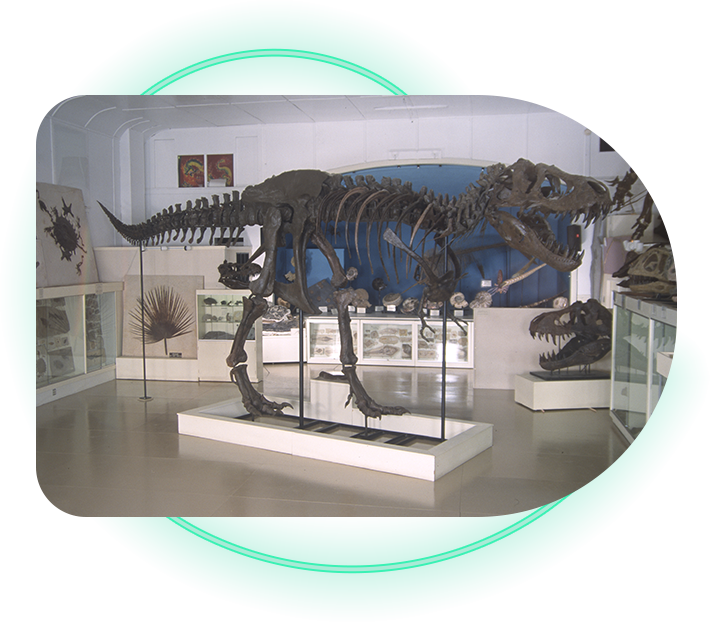Favorite CollLection Triceratops Real Figure Keyring
$11.95
The story of STAN™, the Tyrannosaurus rex, began 65 million years ago in the heart of what is known today as North America. By studying the earth, along with fossil bones and plants, scientists can piece together a picture of what life was like then – and how this largest carnivore to walk the Earth lived out his days.

Tyrannosaurus lived first in Asia, where T. rex’s smaller great-great-grandparent, Tyrannosaurus bataar, reigned. A half-million years before STAN™ was born T. bataar’s descendants crossed over into this continent, evolved into T. rex – and grew. The area they saw looked completely different from our world today. Then, South Dakota closely resembled the Mississippi delta, with richly diverse subtropical plants and animals. (Now, the high plains are scorched during hot, dry summers and lie frozen during below-zero winters!) STAN™’s world included palm, ginkgo, and redwood trees, and many types of ferns, but no grasses. Crocodiles, flying reptiles, large lizards and small mammals lived there, along with a host of dinosaurs, including: Triceratops, Edmontosaurus (a duckbill) , Ankylosaurus, Pachycephalosaurus, and Thescelosaurus (all T. rex food); as well as the meat-eaters Nanotyrannus, Struthiomimus, Chirostenotes, and Dromaeosaurus.
After studying T. rex specimens found together, we believe that STAN™ lived his life in a family group. Hatching from an egg (like a modern bird), STAN™ would have been cared for by his parents, who taught him and his siblings to hunt. Eventually, STAN™ left the family group and found his own mate, a female 30% heavier than himself and with whom he probably spent the rest of his life. STAN™ and his mate fought many battles during their lifetimes – some with other T. rex! For example, each attack to bring down a prey animal not only afforded the opportunity to dine, but also the possibility of injury, and competition. STAN™’s skeleton, along with those of other rex specimens, shows the scars of ancient battles. By studying these “pathologies” in the bones, we surmise that rex scuffled for territory, fought over food, and engaged in other behaviors similar to today’s carnivores.

STAN™’s pathologies include several broken and healed ribs, with one scar the same size and shape as a T. rex tooth. STAN™ has also suffered a broken neck. In the process of healing, two vertebrae fused together and a third became immobilized by extra bone growth (apparently, his spinal cord was not severed, or he would not have lived to heal). His cheeks also show healed injuries, but probably the most chilling is a healed injury on the back of the brain case. Through the back of the skull, we found a circular hole more than one inch in diameter – into which a T. rex tooth fits nicely. The hole ends at a spot where a large chunk of bone (two by five inches) actually broke away! Amazingly, STAN™ lived through this incredible injury, because a thin layer of bone sealed the broken surface.
Whatever the immediate effect of these injuries, STAN™ lived through them to fight another day. We are not sure what finally killed him. Perhaps it was disease or old age. At any rate, his female companion finally had to leave STAN™ on the sand bar of a stream flowing southeastward to the sea. As STAN™’s carcass rotted in the sun, scavengers pulled apart much of the skeleton and skull. Spring floods eventually covered the bones, which
remained buried for sixty-five million years.
In the Spring of 1987, amateur paleontologist STAN™ Sacrison was exploring outcrops of the Hell Creek Formation near the town of Buffalo, South Dakota, when he came across a large pelvis weathering out of a sandy cliff face 100 feet above the prairie. During that summer, STAN™ spent his free time attempting to uncover what was obviously the skeleton of a large dinosaur. It wasn’t until the Spring of 1992 that Black Hills Institute workers began excavation of the dinosaur, which was named after his discoverer. After more than 30,000 hours of preparation, the specimen was ready for exhibit. STAN™ is one of the largest and most complete (65% real bone) T. rex available to science, headlined The T. rex World Exposition which opened its Japanese tour in Tokyo during July, 1995. The T. rex World Exposition toured major Japanese cities for a full year.
The STAN™ exhibit of the Museum at Black Hills Institute features a full sized, research quality replica of the STAN™ skeleton, as well as museum quality paleontologically accurate replicas and fossils of dinosaur skeletons, dinosaur skulls, dinosaur bones, dinosaur teeth, dinosaur claws, and more. You can see the museum house and location here, please come visit us soon!
Cast replicas of STAN™’s magnificent skeleton, skull, teeth and claws are available for sale or rent from the Institute.